
Barry's Mix Magazine Equipment And Software Reviews
Barry's Massive Discography And Engineering Career
Barry's Music Connection Magazine Reviews
Barry's Resolution Magazine Reviews
Focusrite Scarlett Plug-in Suite
![]() Mix Magazine "Compression And Compressors"
Mix Magazine "Compression And Compressors"
By Barry Rudolph

Focusrite's Scarlett plug-in suite is a set of professional processors selling at the decidedly non-professional price of $99. Available in boxed or downloadable versions, it comes in AU, RTAS and VST formats for both Mac and PC hosts (no TDM). Reminiscent of Focusrite's ISA and Red Series hardware, Scarlett was developed by the Forté Suite designers. Get More From Four
Once the suite was into my Pro Tools HD3 Accel rig on a Mac PPC quad-core running OS 10.4.11, I started with the Scarlett compressor and found it especially smooth on bass guitar. Just 2 or 3 dB of compression at 3:1 ratio, 2ms attack time and a 1-second release brought dynamic steadiness to a jumpy performance. Two large VU meters accurately reflect the compressor's action, although gain reduction is measured upward--opposite to most gain-reduction meters. On electric guitars, I loved the sound of the factory Tight Limiter preset for dynamically shaping a pushy eighth-note rhythm guitar part to fit better in the song. I used both Scarlett EQ and compressor on the lead vocal--a good combo because after rolling out mic proximity with the EQ's Shelf section and brightening with the high-mid sections, the overall sound got thin. But following it with the Scarlett compressor warmed and fattened it back up nicely.
The Scarlett reverb is handy for inserting on individual tracks or for adding more reverb to another reverb. When setting this up and dialing in the reverb parameters, advance the wet/dry to wet to first understand the nature of the reverb. You'll hear the built-in pre-delay and how the Size, Pre-Filter and Air parameters affect the reverb's sound. This is a present-sounding reverb that worked well in good amounts for electric guitars and keyboards, and in smaller amounts on vocals.
On electric guitars, I used the low-shelf EQ for clearing out speaker "chuffing"--low midrange mud--and then pushed the upper midrange for articulation with both the low-mid and high-mid parametric settings.
I tried an old disco trick by routing the drum machine kick-drum track to bus 1 and the bass guitar track to bus 2. I set up a stereo aux fader (whose input was bus 1 and 2) and inserted the stereo Scarlett gate. Scarlett caused the kick to trigger the bass. This worked great because the machine kick-drum pattern was strictly on time, fast and busy while the bass player played legato. For purposes a regimented sound, the producer loved that Scarlett's Gate only passed bass guitar audio whenever the kick drum hit. Undeniably Suite
|
|
|
|
All Web Page Design Is Copyright © 2010 through By Barry Rudolph